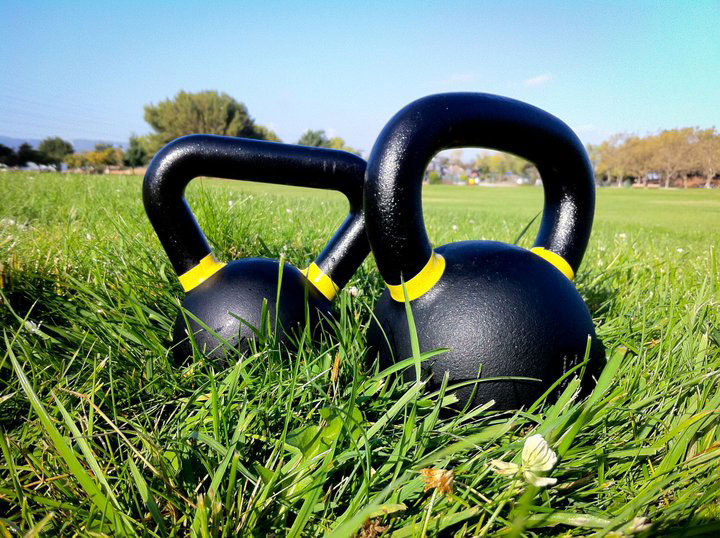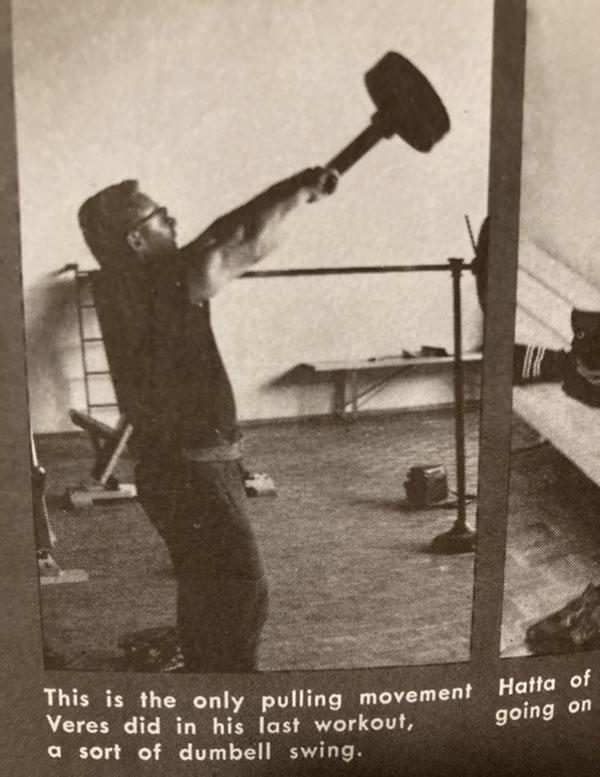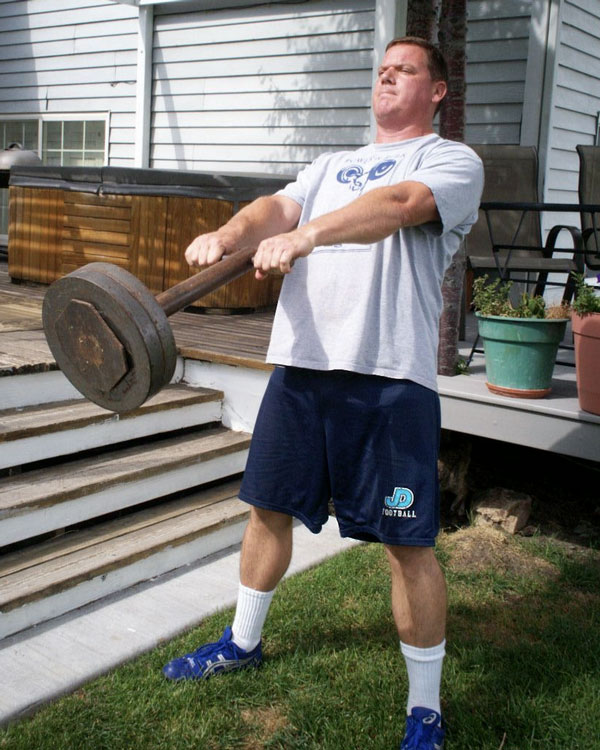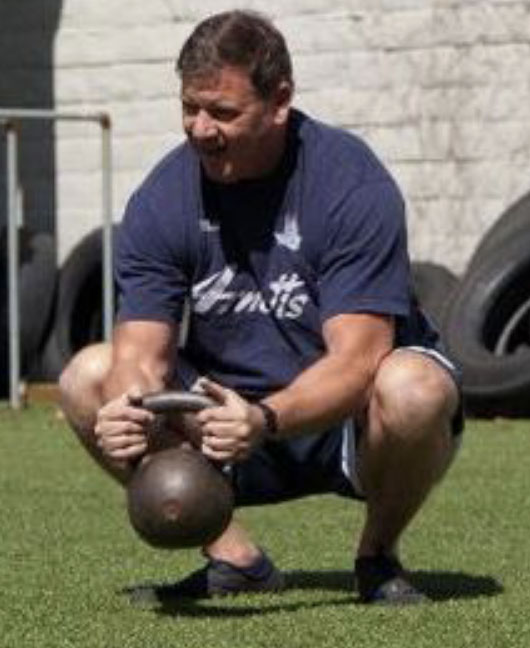Why I Have Been Using Kettlebells for 20 Years — And Am Not About to Stop.
By Dan John

When I first started online, the internet, at least for health and fitness, was a bit of a joke. Most sites were proud "HIT Jedis," the high intensity, machine-based (usually), one-set-to-failure trainees who proudly proclaimed to be "hardgainers." The answer to most questions was to take more time off between training sessions as the body needed to recover more for the once-a-week training…in some cases.
I don’t think I am exaggerating. Fortunately, I found a few people, like Tamir Katz, who encouraged me to write about the weightlifting tradition. From there, I met many others.
You see, you simply don’t understand the internet of 1998. The forums, like the original Old School site, were conversations with NFL and Division One strength coaches talking about the real world of strength and conditioning. And then…the trolls showed up.
Generally, the trolls were simply jerks and/or 14-year-old boys from places like Nebraska. One of my friends searched down the person who critiqued everything that my friend wrote. The keyboard warrior was a zit-faced buffoon from Nebraska. This whole story still brings me joy.
I used to print off emails and articles as I was sure that this internet thing was a lark. Here’s the thing, too: back then, people responded with full sentences, paragraphs, and witty responses to emails!
My first two emails EVER were to Mr. Ripped, Clarence Bass, and one of the real founders of the paleo diet, Robb Wolf. People used to post entire emails that one could "mine" for addresses and that’s how I found their information. I still chat with Clarence every so often as, like the old joke about dads, HE seems to get smarter every year.
Oddly, my first introduction to
kettlebells came from a workshop review from Jason Keen. He had gone to a $51 workshop in Minnesota. Pavel was talking on strength and John Du Cane was also in the audience. I reviewed all of this in one of my books:
My approach to coaching changed when I read a post by Jason F. Keen highlighting a $51 workshop he attended in Minnesota. I printed it out on May 2, 2000, because back then, I figured nothing would stick around on the internet.
Now, I know better: Good information vanishes overnight on the ’net, but that one drunken butt-cheek photo has a life of its own.
Jason gave an overview of a talk by
Pavel Tsatsouline. At the time, Pavel was making a name for himself in Minnesota and soon, with John Du Cane, would change the lifting world with the reintroduction of kettlebells.
"The basic premise Pavel holds dear is strength equals tension. We need to learn to not contract as fast as possible, but to learn to contract as hard as possible."
What got me interested is that I had found myself using the same basic reps schemes that Pavel had discussed in the workshop. I had already established my little "Rule of Ten" for the big lifts:
Basically, you have ten good reps a day with the big efforts on the big lifts. Press, snatch, clean, jerk, squat and deadlift take a LOT out of you. I was playing around with:
- Two sets of five
- Three sets of three
- Five sets of two
My friend, Bishop, gave me the same idea. He told me while we were cooling off under a coliseum at a track meet that he had discovered that "5-3-2" was the key to his improvement. A set of five, go heavier, a set of three, go heavier, and finally, he told me, a double. "NO fuzzy logic," he said, "You HAVE to make the double!"
Every Friday "back in the day," T-nation would release five articles. I would refresh the site for a few hours to be able to read what was new and wonderful. The original dragondoor forums and article areas were deep in materials that I still review these twenty plus years later. I’m not sure how many times I have read and reread Barry Ross’s sprint articles on the site.
Floating around the DD discussion was the kettlebell. I had first seen Kettlebells at the College of San Mateo when the Soviet hammer throwers were tossing them on the football field (I’m sure that went over well). When I popped open my 1971 Track and Field Omnibook written by J. K. Doherty, I saw these used in training for every track and field event.
I felt that I "knew" kettlebells. I guess one can know the ocean, outer space, rattlesnakes, and parenting by reading some books and poems and watching some films, but the experience is far different.
Yes, I knew kettlebells. I just didn’t know anything about them!
My first formal education in kettlebells came when I was prepping up to throw at the University of California, San Diego. A friend of mine had these weird cannonballs with handles and he showed me a "swing." If you compare the flailing and failings of a drowning person to an elite swimmer, you can get a sense of what I was doing.
I was flailing.
I was failing.
It was fun.
My first "aha" moment with kettlebells happened at the Ultraweight championships. That’s the fun competition where we throw the 35 pound weight, the 56 pound weight, the 98 pound weight, the 200 pound weight, and the 300 pound weight.
You read that right. "Throw a 300 pound weight." Yup. For you Metcon people, yes, I know: how easy.
You only throw it once and then get to rest. So easy.
A friend of mine, Dan Gushard, showed up to cheer me on. The meet was poorly run, and I was told I would be finished by noon. At five o’clock, I had yet to throw any of the events. Folks, that’s eight hours of standing around in Seattle. The weather changed every half an hour.
Finally. Finally, my group got to throw. I told Dan that I was stiff and cold. Dan went to his car, brought out a
24k bell and showed me how to swing.
Within minutes, I became, and remain, the kettlebell’s biggest fan.
I was oddly warm, oddly out of breath, and oddly impressed.
My first kettlebell was a handmade "Hungarian Core Blaster." I had seen something like the swing in a 1968 edition of Strength and Health.

An online friend figured out how to build one and I started training in my backyard with it.

My first actual kettlebell came when DD had a huge convention down in Las Vegas. I was in the city that weekend at a track meet attempting to break the world record in the weight pentathlon. I was way ahead of all the numbers when the head official came over to me to tell me that, although promised, they did NOT have a legal javelin.
Anywhere.
At a Division One university.
Alas.
Smelling like a goat, I visited the conference. I was prepped to speak the next day on modern training for throwers (one of my first national talks) but I arrived in time to compete in the kettlebell for distance competition. I took second.
My old friend from Seattle, Dan Gushard, beat me. I took second but was given a
24k bell as an award. I have used this bell at least weekly since that day and I doubt the "end is near." It does have some weird paint drippings on it from living in a garage, but he is a faithful friend.
With my career and kids, I couldn’t break away for a
certification for a few years. When asked, I told people that I was worried about missing practice as, I would explain, "something stupid would happen."
Finally, I was able to make a cert. San Jose. I was so excited. When I got off the plane, my phone was choked with voicemails and calls.
At practice, one of my athletes fell off the roof. Now, when you get a minute, ask yourself why the athlete was ON the roof. Then, figure out how on a perfectly wonderful day, he had the ability to fall off this roof.
You see, I knew my athletes would figure out a way to do something! He is/was fine. We had someone overreact to the whole situation and worry far too much. We used to joke after that incident that he was fine…he fell on his head.
I knew something stupid would happen!
The San Jose cert is famous for being one of the hardest ever. For some reason, every time a plane landed or took off, we were expected to do 20 swings. We did.
We were next to an airport. Do the math.
What impressed me the most, and hats off to John Du Cane for this, my evaluations were overall positive, but I was clear in my criticism about the plane/swing thing and the fact that the Turkish get up was taught three different ways with no actual clarity. Famously, I assisted in the squat and introduced the Goblet Squat.
For years, we joked that I was the only person ever to teach at their own cert. But, here’s the thing: I was an assistant at the next cert at UCLA…with my daughter, Kelly, whose classmate fell off the roof.
Yes, we did swings. A lot. But they were organized and logical. The entire section on the TGU was rewritten and codified…with the wiggle room to improve. The squat section, proudly taught by me, featured the Goblet Squat.
Make sure you understand my point: Yes, the kettlebell is amazing for conditioning, challenges, training, body composition, and athletic performance.
The basic six movements can be studied for decades and still be improved.
But don’t miss this: the reason the
RKC is so damn good with kettlebells is that we allow, we demand, feedback and don’t shy away from learning from mistakes, errors, or simply "better." Sitting on the floor in the corner by itself, the kettlebell is just another load in the gym. With the
RKC community, it becomes a stand-alone tool for all kinds of uses in health, fitness, longevity, body composition, and performance.
I’ve used kettlebells to help throwers, Olympic lifters, American football players, military, elderly, and youth to become better and brighter at everything they do.
My trusty
24kg kettlebell has been with me through multiple surgeries and life changes. When I came back from a Total Hip Replacement, my first test was with the 28k Goblet Squat (after appropriate rehab and clearance).

It’s been a fun two plus decades. It’s a rare day that I don’t press or squat a kettlebell. I still do my annual 10,000 swing challenge. I have some ideas about a snatch challenge. I worked with my young up and coming superstar discus thrower this morning with some fundamental kettlebell movements.
The
kettlebell remains my favorite tool in my gym. I have 32 of them and each one of them gets dragged out to the floor each week. When I started kettlebells, I had no idea that the BEST years of my athletic career were ahead of me (my peak year as a thrower was at age 47). Now, I sit here with my Medicare card prepping up to break the American records in the Olympic lifts.
Yes, it’s a tool. Yet, combined with a community of fellow seekers, the kettlebell can change lives.
It changed mine.
Back